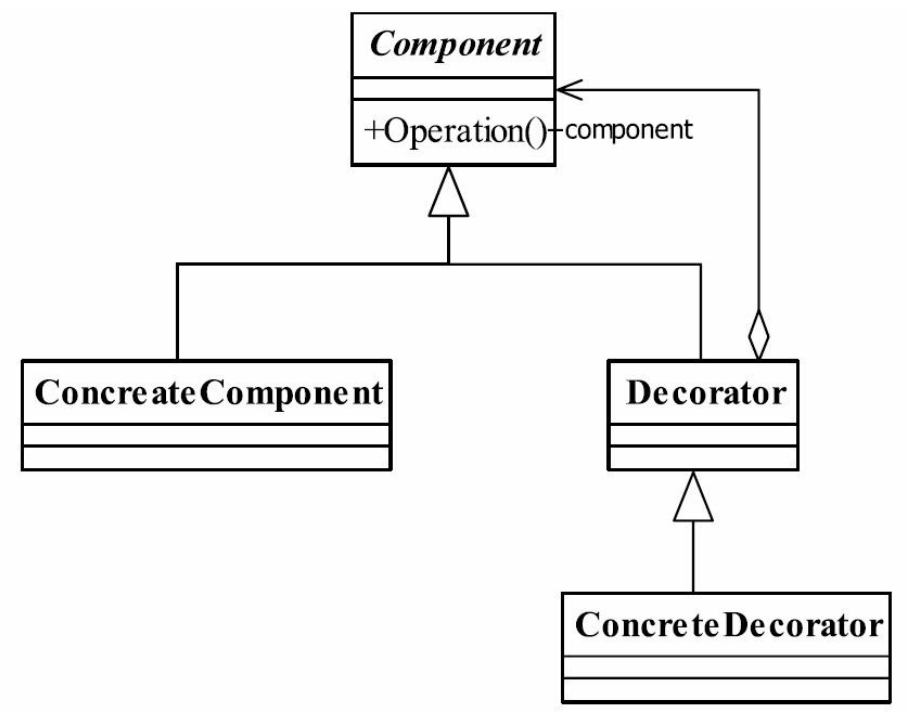哈喽,大家好,我是指北君。
今天给大家介绍另一种常用的设计模式——装饰器模式。
1.什么是装饰器模式?
Attach additional responsibilities to an object dynamically keeping the same interface.Decorators provide a flexible alternative to subclassing for extending functionality.
装饰器模式(Decorator Pattern):动态的给一个对象添加额外的职责,就增加功能来说, 装饰模式相比生成子类更为灵活。
说人话:一般的,我们为了扩展一个类经常使用继承方式实现,随着扩展功能的增多,子类会很膨胀。这时候期望在不改变类对象及其类定义的情况下,为对象添加额外功能,这就是装饰器模式。
2.装饰器模式定义

①Component抽象构件
Component是一个接口或者是抽象类, 就是定义我们最核心的对象, 也就是最原始的对象。
②ConcreteComponent 具体构件
ConcreteComponent是最核心、 最原始、 最基本的接口或抽象类的实现, 你要装饰的就是它。
③Decorator装饰角色
一般是一个抽象类, 实现接口或者抽象方法, 它里面可不一定有抽象的方法, 在它的属性里必然有一个private变量指向Component抽象构件。
④ConcreteDecorator 具体装饰角色
ConcreteDecoratorA和ConcreteDecoratorB是两个具体的装饰类, 你要把你最核心的、 最原始的、 最基本的东西装饰成其他东西
3.装饰器模式通用代码实现
/**
* 抽象构件
*/
public abstract class Component {
public abstract void operator();
}- 1.
- 2.
- 3.
- 4.
- 5.
- 6.
/**
* 具体构件
*/
public class ConcreteComponent extends Component{
@Override
public void operator() {
System.out.println("doSomething");
}
}- 1.
- 2.
- 3.
- 4.
- 5.
- 6.
- 7.
- 8.
- 9.
/**
* 抽象装饰者
*/
public abstract class Decorator extends Component{
private Component component;
public Decorator(Component component){
this.component = component;
}
// 委托给被修饰者执行
@Override
public void operator() {
this.component.operator();
}
}- 1.
- 2.
- 3.
- 4.
- 5.
- 6.
- 7.
- 8.
- 9.
- 10.
- 11.
- 12.
- 13.
- 14.
- 15.
- 16.
public class ConcreteDecorator1 extends Decorator{
// 定义被修饰者
public ConcreteDecorator1(Component component){
super(component);
}
// 定义自己的修饰方法
public void method1(){
System.out.println("修饰方法 method1");
}
@Override
public void operator() {
this.method1();
super.operator();
}
}- 1.
- 2.
- 3.
- 4.
- 5.
- 6.
- 7.
- 8.
- 9.
- 10.
- 11.
- 12.
- 13.
- 14.
- 15.
- 16.
客户端测试:
public class DecoratorClient {
public static void main(String[] args) {
Component component = new ConcreteComponent();
// 第一次修饰
component = new ConcreteDecorator1(component);
// 第二次修饰
component = new ConcreteDecorator2(component);
// 修饰后运行
component.operator();
}
}- 1.
- 2.
- 3.
- 4.
- 5.
- 6.
- 7.
- 8.
- 9.
- 10.
- 11.
打印结果:

4.装饰器模式优点
①装饰模式可以动态地扩展一个实现类的功能。
②装饰类和被装饰类可以独立发展, 而不会相互耦合。换句话说, Component类无须知道Decorator类, Decorator类是从外部来扩展Component类的功能, 而Decorator也不用知道具体的构件。
③装饰模式是继承关系的一个替代方案。我们看装饰类Decorator, 不管装饰多少层, 返回的对象还是Component, 实现的还是is-a的关系
5.装饰器模式应用场景
①、需要扩展一个类的功能, 或给一个类增加附加功能。
②、需要动态地给一个对象增加功能, 这些功能可以再动态地撤销。